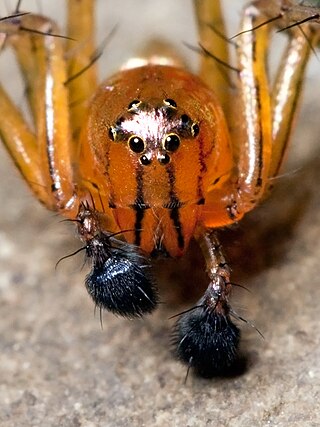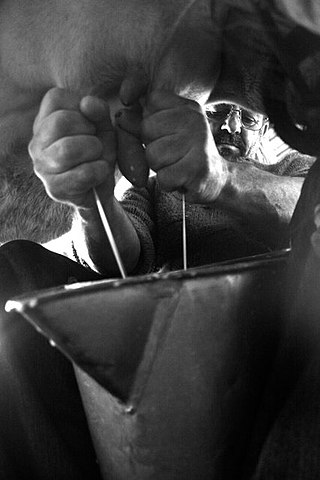
A camel is an even-toed ungulate in the genus Camelus that bears distinctive fatty deposits known as "humps" on its back. Camels have long been domesticated and, as livestock, they provide food and textiles. Camels are working animals especially suited to their desert habitat and are a vital means of transport for passengers and cargo. There are three surviving species of camel. The one-humped dromedary makes up 94% of the world's camel population, and the two-humped Bactrian camel makes up 6%. The wild Bactrian camel is a separate species and is now critically endangered.

Arachnida is a class of joint-legged arthropods, in the subphylum Chelicerata. Arachnida includes, among others, spiders, scorpions, ticks, mites, pseudoscorpions, harvestmen, camel spiders, whip spiders and vinegaroons.

Pedipalps are the secondary pair of forward appendages among chelicerates – a group of arthropods including spiders, scorpions, horseshoe crabs, and sea spiders. The pedipalps are lateral to the chelicerae ("jaws") and anterior to the first pair of walking legs.

The orthopteran family Rhaphidophoridae of the suborder Ensifera has a worldwide distribution. Common names for these insects include cave crickets, camel crickets, Hogan bugs, spider crickets, land shrimp, and sand treaders. Those occurring in New Zealand are typically referred to as jumping or cave wētā. Most are found in forest environments or within caves, animal burrows, cellars, under stones, or in wood or similar environments. All species are flightless and nocturnal, usually with long antennae and legs. More than 500 species of Rhaphidophoridae are described.

Solifugae is an order of animals in the class Arachnida known variously as camel spiders, wind scorpions, sun spiders, or solifuges. The order includes more than 1,000 described species in about 147 genera. Despite the common names, they are neither true scorpions, nor true spiders. Most species of Solifugae live in dry climates and feed opportunistically on ground-dwelling arthropods and other small animals. The largest species grow to a length of 12–15 cm (5–6 in), including legs. A number of urban legends exaggerate the size and speed of the Solifugae, and their potential danger to humans, which is negligible.

Camel toe, or cameltoe, is slang for the outline of the labia majora in tightly fitting clothes. Owing to a combination of anatomical factors and the fabric tension in the crotch area, the outer labia and mons pubis may, together, display a shape resembling the forefoot of a camel. Camel toe commonly occurs as a result of wearing clothing with crotch-area vertical tension, such as Spandex activewear or athleisure bottom wear, hotpants or swimwear.

Milking is the act of removing milk from the mammary glands of cattle, water buffalo, humans, goats, sheep, and, more rarely, camels, horses, and donkeys. Milking may be done by hand or by machine, and requires the animal to be currently or recently pregnant. The milker may refer either to the animal that produces the milk or the person who milks said animal.

Latrodectus tredecimguttatus, also known as the Mediterranean black widow or the European black widow, is a species in the genus Latrodectus of the widow spiders. It is commonly found throughout the Mediterranean region, ranging from southern Iberia to southwest and central Asia, hence the name. Specimens from central Asia are also known by the binomial name Latrodectus lugubris; that name, however, is now considered improper, though it is still commonly found in the literature. Latrodectus tredecimguttatus was previously considered a subspecies of Latrodectus mactans.

Animal fibers are natural fibers that consist largely of certain proteins. Examples include silk, hair/fur and feathers. The animal fibers used most commonly both in the manufacturing world as well as by the hand spinners are wool from domestic sheep and silk. Also very popular are alpaca fiber and mohair from Angora goats. Unusual fibers such as Angora wool from rabbits and Chiengora from dogs also exist, but are rarely used for mass production.

The River Allen in north Cornwall is one of two rivers in Cornwall which share this name. In this case the name is the result of a mistake made in 1888 by Ordnance Survey, replacing the name Layne with Allen which is the old name for the lower reaches of the Camel. The other River Allen runs through Truro.
Willa's Wild Life is a preschool animated television series based on Dan Yaccarino's book An Octopus Followed Me Home. The series originally aired on Qubo in the United States, YTV in Canada and TF1 and Piwi+ in France. The series is Flash-animated with Toon Boom Harmony. International airings aired from October 7, 2008 to June 27, 2013. 26 episodes were produced.

The De Lank River is a small river in north Cornwall, England. It is a tributary of the River Camel and is approximately nine miles (14.5 km) long from its source on Bodmin Moor to its confluence with the Camel two miles (3 km) south of St Breward.

Camel Spiders is a 2011 made-for-television horror sci-fi film starring Brian Krause, C. Thomas Howell, and Jessica Cameron. It was directed by genre veteran Jim Wynorski and executive-produced by Roger Corman. The typography on the DVD cover art bears a striking resemblance to that which is used on Camel Cigarettes packaging.

The cuisine of Mauritania includes the culinary practices of Mauritania. Historically, what is now Mauritania has been influenced by Arab, Berbers and African peoples who have lived in and traversed the "stark" landscape marked with Sahara desert dunes in caravans. There is an overlap with Moroccan cuisine in the north and Senegalese cuisine in the south.

Spider-Verse is a comic book series issued by Marvel Comics since 2014. Its first major event/storyline started on November 5 in The Amazing Spider-Man (2014) #9 along with an individual issue named Spider-Verse Team-Up. This event took 20 publications to be completed and featured nearly every variant of Spider-People and Spider-Man that had appeared in the comics and other media in the over fifty years since Spider-Man's creation, all under attack by Morlun and his family, the Inheritors. This first major storyline, however, was preceded by a full-flagged Spider-Verse series titled Edge of the Spider-Verse, which served to introduce some new characters that would lead the event, such as Spider-Gwen and Miguel O’Hara.

Galeodes arabs, common name Egyptian giant solpugid or camel spider, is a species of solifuges native to North Africa and Western Asia.

The Legend of the Christmas Spider is an Eastern European folktale which explains one possible origin of tinsel on Christmas trees. It is most prevalent in Western Ukraine, where small ornaments in the shape of a spider are traditionally a part of the Christmas decorations.
Cratosolpuga is an extinct genus of solifuge from the Early Cretaceous Araripe Basin of Brazil. It contains the single species Cratosolpuga wunderlichi. The genus is known from and named after the Crato Formation.

A spiracle or stigma is the opening in the exoskeletons of insects, myriapods, velvet worms and many arachnids to allow air to enter the trachea. In the respiratory system of insects, the tracheal tubes primarily deliver oxygen directly into the animals' tissues. In most species the spiracles can be opened and closed in an efficient manner to admit air while reducing water loss. In various species, this is done by a wide range of mechanisms, such as elastic closure, and closer muscles surrounding the spiracle or kinking the tube. In some the muscle relaxes to open the spiracle, in others to close it. The closer muscle is controlled by the central nervous system, but can also react to localized chemical stimuli. Several aquatic insects have similar or alternative closing methods to prevent water from entering the trachea. The timing and duration of spiracle closures can affect the respiratory rates of the organism. Spiracles may also be surrounded by hairs to minimize bulk air movement around the opening, and thus minimize water loss.


















